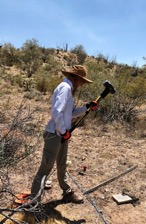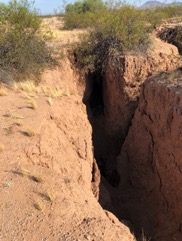—Mari Wuollett, 2019 Herman Bouwer Intern Scholar
Awareness of water resources is vital around the world. In few places is it as glaring as in the heat of Arizona’s summer. This summer, I was fortunate to be selected as the AHS Herman Bouwer Intern Scholarship recipient. During my internships, I gained not only valuable professional experience and advice, but a highly involved look into Arizona’s unique water resources and needs through three distinguished host organizations.
 My first internship was with Wood, in both its environmental and geotechnical groups. This was a great opportunity to see how different scientific backgrounds are applied to help solve engineering and environmental problems in consulting. With the environmental group, I accompanied technical experts in the field for a variety of different projects. I was able to see logging and sampling of soils at an underground storage tank site that was being decommissioned. I also saw how data and samples were gathered from monitoring wells at an active groundwater remediation site. I learned how low-flow sampling and discrete bailing work both are done, as well as how to use a sounder. In the office, I was able to help organize and see how monitoring well data are used. Additionally, I was asked to do a bit of reading research for a larger project that involved preferential pathways for groundwater contamination. My days with the geotechnical group were heavily fieldwork focused but familiar, as my educational background is in geology. I was able to help with seismic surveys, some geologic mapping, and gathering data for engineering purposes. I also saw rock core logging and sampling in addition to soil logging and sampling. Out of the field, I saw how those samples were processed at the materials and engineering lab.
My first internship was with Wood, in both its environmental and geotechnical groups. This was a great opportunity to see how different scientific backgrounds are applied to help solve engineering and environmental problems in consulting. With the environmental group, I accompanied technical experts in the field for a variety of different projects. I was able to see logging and sampling of soils at an underground storage tank site that was being decommissioned. I also saw how data and samples were gathered from monitoring wells at an active groundwater remediation site. I learned how low-flow sampling and discrete bailing work both are done, as well as how to use a sounder. In the office, I was able to help organize and see how monitoring well data are used. Additionally, I was asked to do a bit of reading research for a larger project that involved preferential pathways for groundwater contamination. My days with the geotechnical group were heavily fieldwork focused but familiar, as my educational background is in geology. I was able to help with seismic surveys, some geologic mapping, and gathering data for engineering purposes. I also saw rock core logging and sampling in addition to soil logging and sampling. Out of the field, I saw how those samples were processed at the materials and engineering lab.
 I then spent several weeks with Clear Creek Associates. As a geology student with a keen interest in hydrogeology, this was a great place to see my passion in action. Many of the projects I shadowed involved designing, installing, or rehabilitating wells. I was lucky to see everything from site assessments to how data was gathered for older or damaged wells. Other interesting phases of projects I saw included surface casing installation, annular fill for a partially installed well, and swab and airlift development of a newly finished well. During this time, I learned how to take necessary measurements for well project phases — such as the thickness and diameter of a well casing, or the weight of cement used for the annular seal. I’d learned about constant-rate and step-drawdown pumping tests in the classroom but finally got to help perform both and see the data used to calculate well efficiency and hydraulic properties of the surrounding aquifer. I also learned how to use a combo meter and Imhoff cone to measure important parameters of groundwater samples and gained much more practice with sounders. I was able to sit in on a down-well and borehole video log too, which was a fascinating look into the subsurface. I also shadowed staff on some of Clear Creek’s environmental work and spent a couple days helping to gather monitoring well data and samples. In the office, I got to sit in on a few meetings, including one presentation on a series of well installations that taught the Clear Creek team some valuable practical lessons.
I then spent several weeks with Clear Creek Associates. As a geology student with a keen interest in hydrogeology, this was a great place to see my passion in action. Many of the projects I shadowed involved designing, installing, or rehabilitating wells. I was lucky to see everything from site assessments to how data was gathered for older or damaged wells. Other interesting phases of projects I saw included surface casing installation, annular fill for a partially installed well, and swab and airlift development of a newly finished well. During this time, I learned how to take necessary measurements for well project phases — such as the thickness and diameter of a well casing, or the weight of cement used for the annular seal. I’d learned about constant-rate and step-drawdown pumping tests in the classroom but finally got to help perform both and see the data used to calculate well efficiency and hydraulic properties of the surrounding aquifer. I also learned how to use a combo meter and Imhoff cone to measure important parameters of groundwater samples and gained much more practice with sounders. I was able to sit in on a down-well and borehole video log too, which was a fascinating look into the subsurface. I also shadowed staff on some of Clear Creek’s environmental work and spent a couple days helping to gather monitoring well data and samples. In the office, I got to sit in on a few meetings, including one presentation on a series of well installations that taught the Clear Creek team some valuable practical lessons.
 Finally, my last internship was with ADWR. This was a great place to finish, as water policy often plays a role in how and why many parties — including consulting firms — conduct their business. It was also interesting to see the differences between private and state agencies. Although it was only a week, I visited many sub-departments within ADWR. I first started out with the Arizona Management System to get a sense of how ADWR runs and an overall introduction to the department. I then spent time with Floodplain Management and Records Management. The next 2 days were spent with everyone from the Colorado River Management, Assured and Adequate Water Supply and Active Management Area programs, to the Adjudications team. I even squeezed in a meeting with Director Buschatzke, which was very insightful. I also spent time with the Groundwater Permitting and Wells team, which was an interesting side to see after the many well projects I saw while at Clear Creek Associates. My last 2 days were spent mostly with the Hydrology division’s Field Services and Groundwater Modeling teams. I first went out with Field Services to see ground fissures that have formed due to differential land subsidence from groundwater withdrawal. These types of fissures were something I had seen often in articles and textbooks and I was excited to see them in person. Additionally, we made a stop at a monitoring well, at which we checked the water level with sounders to compare to the transducer data that was being sent to the Hydrology division. The Groundwater Modeling team was also very informative. Modeling has been an aspect of groundwater science that I’ve always wanted to learn more about and getting to see firsthand how it’s being utilized at ADWR was opportune. Ultimately, it was amazing to see how much complicated work is done to manage Arizona’s water.
Finally, my last internship was with ADWR. This was a great place to finish, as water policy often plays a role in how and why many parties — including consulting firms — conduct their business. It was also interesting to see the differences between private and state agencies. Although it was only a week, I visited many sub-departments within ADWR. I first started out with the Arizona Management System to get a sense of how ADWR runs and an overall introduction to the department. I then spent time with Floodplain Management and Records Management. The next 2 days were spent with everyone from the Colorado River Management, Assured and Adequate Water Supply and Active Management Area programs, to the Adjudications team. I even squeezed in a meeting with Director Buschatzke, which was very insightful. I also spent time with the Groundwater Permitting and Wells team, which was an interesting side to see after the many well projects I saw while at Clear Creek Associates. My last 2 days were spent mostly with the Hydrology division’s Field Services and Groundwater Modeling teams. I first went out with Field Services to see ground fissures that have formed due to differential land subsidence from groundwater withdrawal. These types of fissures were something I had seen often in articles and textbooks and I was excited to see them in person. Additionally, we made a stop at a monitoring well, at which we checked the water level with sounders to compare to the transducer data that was being sent to the Hydrology division. The Groundwater Modeling team was also very informative. Modeling has been an aspect of groundwater science that I’ve always wanted to learn more about and getting to see firsthand how it’s being utilized at ADWR was opportune. Ultimately, it was amazing to see how much complicated work is done to manage Arizona’s water.
Having gained such insight, advice, and experience over the summer I’d like to recognize all those who were involved. First and foremost, thank you to AHS, the Phoenix Chapter, and the sponsors of the intern scholarship program. Special thanks to the internship committee for selecting me for this wonderful opportunity and for guiding me through the process. Finally, a big thank you to Wood Plc, Clear Creek Associates and ADWR for hosting me. I met so many knowledgeable and gracious professionals this summer and a few will be reading this; thank you again for taking time out of your days to be a mentor. It is much appreciated. I hope to stay in water resources while I further my academic and professional careers. This opportunity has undoubtably been a launching pad from which I will be able to do so.